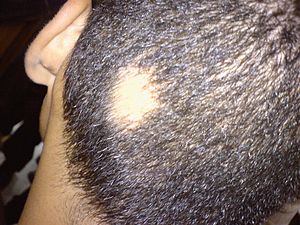圆秃
圆秃(Alopecia Areata),又被称作班秃、鬼剃头、油风等,是一种身体局部或全部毛发脱落的病症。[1][2] 它通常会导致头皮上出现脱发区块,每个约有硬币大小。[3] 心理压力和各种疾病是导致高风险者患病的可能因素,但大多情况下没有明显的触发因素,患者通常在其他方面都很健康。[3] 在少数情况下,头皮上的毛发全部脱落(全秃,alopecia totalis),或体毛全部脱落(Alopecia universalis)。 它有时是永久性的,也可能是暂时的。[3][2] 常在男性身上发生的脂溢性脱发与此不同。
| Alopecia areata | |
|---|---|
 | |
| 类型 | 脱发、自体免疫性疾病、自身免疫性皮肤病[*] |
| 分类和外部资源 | |
| 医学专科 | 皮肤病学 |
| ICD-11 | ED70.2 |
| ICD-10 | L63 |
| ICD-9-CM | 704.01 |
| OMIM | 104000 |
| DiseasesDB | 430 |
| MedlinePlus | 001450 |
| eMedicine | derm/14 |
| MeSH | D000506 |
| Orphanet | 701 |
斑秃被认为是一种自身免疫性疾病,由毛囊的免疫豁免受损引起。[1][4] 风险因素包括该病的家族病史。[3] 在同卵双胞胎中,如果一人受到影响,另一人有约50%机会受影响。[3] 潜在的机制涉及身体无法识别自己的细胞,随后发生由免疫系统介导的毛囊破坏。[3]
目前还没有治愈这种疾病的方法。[3] 一些疗法,特别是去炎松注射液和5%米诺地尔外用乳膏[5][6],可有效加速毛发再生[3][7]。防晒霜、防寒防晒的头罩和眼镜(如果缺少睫毛)也被认为可能有帮助。[3] 在超过50%的突发性局部“斑片状”疾病病例中,头发会在一年内重新长出。[8][9][3] 对于只有一个或两个脱发区块的患者,此一年恢复率将达80%。[10][11] 然而,大多数患者在一生中会经历不止一次发作。[9] 在许多患者中,脱发和再生会在几年内同时发生。[3] 在体毛全部脱落者中的恢复比例不到10%。[12]
约0.15%的人在任何时候受影响,2%的人在某个时间点受到影响。[3][12] 此病经常在成年之前发作。[3],且女性受影响的比率高于男性。[13]
历史记载
编辑鬼剃头一词由来甚久,《黄帝内经》有“毛拔”、“发脱”、“发坠”等病名,《难经》称“毛落”,隋代巢元方的《诸病源候论》说:“人有风邪,有于头,在偏虚处,则发失落、肌肉枯死,或如钱大,或如指大,发不生,亦不痒,故谓之鬼舐头。”《外科正宗》:“乃血虚不能随气荣养肌肤,故毛发根空,脱落成片,皮肤光亮,痒如虫行,此皆风热乘虚攻注而然。”《医宗金鉴》之《外科心法·油风篇》:“此证毛发干焦,成片脱落,皮红光亮……俗名鬼剃头。”[需要可靠医学来源]
中医解释
编辑中医学上认为斑秃是“肝肾亏虚”所致,《诸病源候论·须发脱落篇》记载:“足少阳胆之经也,其荣在须,足少阴肾之经也,其华在发,冲任之脉,均为十二经之海,其别络在上唇口;若血盛则荣于须发,故须发美,若血气衰弱,经脉虚竭,不能荣润,故须发秃落。”如细分下去,可得4种病因:[需要可靠医学来源]
明星个案
编辑- 贝克汉姆与他妻子也发生过同样问题,最后作出人工修补。[需要可靠医学来源]
- 郑秀文(Sammi)左后脑严重脱发致使头皮外露惊见鬼剃头。[需要可靠医学来源]
- 郑丹瑞“阿旦”发现右额出现了鬼剃头,慢慢扩散,愈来愈大。[需要可靠医学来源]
- 卫诗承认因抑郁所致的鬼剃头导致甩发的现象。[需要可靠医学来源]
- AV女优大泽惠曾因鬼剃头而戴假发演出。[需要可靠医学来源]
- 辛东根在2015年承认自2010年有严重脱发症,所以把头发剃光后,会以帽子造型示众。[需要可靠医学来源]
- 匹兹堡钢人中线卫Ryan Shazier和篮球员查理·维拉纽瓦天生患有全身性秃发症,所以全身几乎没有毛发。对全身没有其他伤害。[需要可靠医学来源]
- 演员洁达·𬞟姬·史密斯2018年诊断出脱发症,自此剃光头示人。
- 本来挑染成金色长发的前西贡区议员王卓雅曾在facebook刊登因政治压力所致的鬼剃头导致甩发现象的照片,更寄语所有斑秃或鬼剃头的患者︰“You are not alone.”
参考资料
编辑- ^ 1.0 1.1 Erjavec SO, Gelfman S, Abdelaziz AR, Lee EY, Monga I, Alkelai A, Ionita-Laza I, Petukhova L, Christiano AM. Whole exome sequencing in Alopecia Areata identifies rare variants in KRT82. Nat Commun. Feb 2022, 13 (1): 800. Bibcode:2022NatCo..13..800E. PMC 8831607 . PMID 35145093. doi:10.1038/s41467-022-28343-3.
- ^ 2.0 2.1 Alopecia Areata - Symptoms, Causes, Treatment | NORD. rarediseases.org. [2023-05-26]. (原始内容存档于2017-02-21) (美国英语).
- ^ 3.00 3.01 3.02 3.03 3.04 3.05 3.06 3.07 3.08 3.09 3.10 3.11 3.12 Liaison, Ray Fleming, Office of Communications and Public. Questions and Answers About Alopecia Areata. NIAMS. May 2016 [10 July 2017]. (原始内容存档于4 July 2017) (英语).
- ^ Rajabi, F.; Drake, L.A.; Senna, M.M.; Rezaei, N. Alopecia areata: A review of disease pathogenesis. British Journal of Dermatology. 2018, 179 (5): 1033–1048. PMID 29791718. S2CID 43940520. doi:10.1111/bjd.16808.
- ^ Yee, Brittany E.; Tong, Yun; Goldenberg, Alina; Hata, Tissa. Efficacy of different concentrations of intralesional triamcinolone acetonide for alopecia areata: A systematic review and meta-analysis. Journal of the American Academy of Dermatology. 1 April 2020, 82 (4): 1018–1021 [16 November 2022]. ISSN 0190-9622. PMID 31843657. S2CID 209389315. doi:10.1016/j.jaad.2019.11.066. (原始内容存档于15 April 2023) (英语).
- ^ Freire, PCB; Riera, R; Martimbianco, ALC; Petri, V; Atallah, AN. Minoxidil for patchy alopecia areata: systematic review and meta-analysis.. Journal of the European Academy of Dermatology and Venereology. September 2019, 33 (9): 1792–1799. PMID 30835901. S2CID 73460786. doi:10.1111/jdv.15545.
- ^ Alopecia Areata - Symptoms, Causes, Treatment | NORD. rarediseases.org. [2023-05-26]. (原始内容存档于2017-02-21) (美国英语).
- ^ Paggioli, Isabelle; Moss, Jeremy. Alopecia Areata: Case report and review of pathophysiology and treatment with Jak inhibitors. Journal of Autoimmunity. 1 December 2022, 133: 102926 [16 November 2022]. ISSN 0896-8411. PMID 36335798. S2CID 253320808. doi:10.1016/j.jaut.2022.102926. (原始内容存档于15 April 2023) (英语).
- ^ 9.0 9.1 Alkhalifah, A; Alsantali, A; Wang, E; McElwee, KJ; Shapiro, J. Alopecia areata update: part I. Clinical picture, histopathology, and pathogenesis.. Journal of the American Academy of Dermatology. February 2010, 62 (2): 177–88, quiz 189–90. PMID 20115945. doi:10.1016/j.jaad.2009.10.032.
- ^ Spano, Frank; Donovan, Jeff C. Alopecia areata. Canadian Family Physician. September 2015, 61 (9): 751–755. ISSN 0008-350X. PMC 4569104 . PMID 26371097.
- ^ Mounsey, Anne L.; Reed, Sean W. Diagnosing and Treating Hair Loss. American Family Physician. 15 August 2009, 80 (4): 356–362 [16 November 2022]. PMID 19678603. (原始内容存档于16 November 2022).
- ^ 12.0 12.1 Beigi, Pooya Khan Mohammad. Alopecia Areata: A Clinician's Guide. Springer. 2018: 14 [1 October 2020]. ISBN 9783319721347. (原始内容存档于14 January 2023) (英语).
- ^ Lundin, Michael. Gender differences in alopecia areata. Journal of Drugs in Dermatology (United States National Library of Medicine). 13 April 2014, 13 (4): 409–413 [4 April 2022]. PMID 24719059. (原始内容存档于5 April 2022).
A higher incidence rate of AA in the female population is well described. It is unclear why females are more likely to be diagnosed with AA and what, if any, differences in disease phenotype exist between males and females.